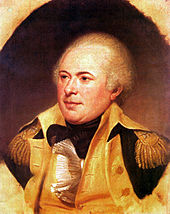Battle of Lacolle Mills (1814)
| Battle of Lacolle Mill | |||||||
|---|---|---|---|---|---|---|---|
| Part of the War of 1812 | |||||||
 Lacolle Mills Blockhouse | |||||||
| |||||||
| Belligerents | |||||||
|
|
| ||||||
| Commanders and leaders | |||||||
|
|
| ||||||
| Strength | |||||||
| 80 (Reinforced by 400) | 4,000 | ||||||
| Casualties and losses | |||||||
|
61 killed 44 wounded 4 missing[1][2] |
254 killed 128 wounded 13 missing[1][2] | ||||||
The Battle of Lacolle Mills was fought on 30 March 1814 during the War of 1812. The small garrison of a British outpost position, aided by reinforcements, fought off a large American attack.
Despite being outnumbered 12-1, the British pulled off the victory, due to their well-trained and high morale men defeating a non-experienced American group.
Background
After the St. Lawrence campaign had ended late the previous year with the British victory at the Battle of Crysler's Farm, the defeated American Army under Major General James Wilkinson went into winter quarters at French Mills, New York, only just inside the United States. The British commanders feared that the Americans could threaten the British line of communication along the St. Lawrence River from this position,[3] but Wilkinson made no attempt to do so. His army arrived at French Mills with few supplies, and because of poor roads, lack of transport and draught animals and inefficiency of the Quartermaster General's Department, it was almost impossible to supply the army in this advanced position.[4] Sickness rapidly increased until there were no less than 450 sick in squalid conditions in a hospital in Malone, New York and many more in French Mills.

Finally, in late January, Secretary of War
Wilkinson was aware that he would almost certainly be removed from command following the defeat of the St. Lawrence campaign, and planned several offensives to restore his reputation. Most of these were too ambitious with the means available, but one objective seemed feasible. A few miles north of the border between Canada and the United States, the main road running north crossed the small
Battle
Wilkinson marched northwards from Plattsburgh to attack this outpost on 27 March 1814. His force consisted of 4,000 men organised into three brigades, with 11 pieces of artillery. The march was delayed by deep snow and mud, and he was not able to occupy

The Americans opened fire with two 12-pounder cannon and a 5.5 inch mortar. They could not bring an 18-pounder gun into action because of soft ground around the area. The British garrison fired back with their Congreve rockets. Although the rockets were inaccurate, they caused several American casualties. The American troops had not encountered these weapons before in battle and were unnerved.
The flank (i.e. the Light and Grenadier) companies of the 13th had been stationed nearby. They launched a bayonet charge against the American artillery emplacements, but only 80[
By evening, the Americans had made little impression on the British defences. Rather than launch an all-out assault, Wilkinson ordered a retreat. The Americans returned to Plattsburgh, considerably disheartened. Wilkinson had recklessly exposed himself to British fire throughout the action, though to little purpose.[6]
Aftermath

On 11 April, Wilkinson received orders from Armstrong relieving him of command. This was probably not a direct result of the debacle at Lacolle Mills, but followed a request made by Wilkinson himself on 24 March for a Court of Enquiry to rule on his conduct of the St. Lawrence campaign the previous year.
The failure nevertheless allowed Armstrong to promote a crop of comparatively junior officers to command divisions and brigades. Major General George Izard, who had been on leave when the Battle of Lacolle Mills was fought, eventually took command at Plattsburgh.
Legacy
The 13th Regiment of Foot is perpetuated in the British Army by
The site of the battle was designated a National Historic Site of Canada in 1923.[13]
See also
- Battle of Lacolle Mills (1812)
- John L. Gardner (brigadier general) Present at Battle of Lacolle Mills (not as Brig.General)
Notes
- ^ a b - Access Heritage
- ^ a b - World History
- ^ J. Mackay Hitsman, The Incredible War of 1812, p.205
- ^ John R. Elting, Amateurs to Arms, p.152
- ^ a b John R. Elting, Amateurs to Arms, p.175
- ^ a b c J. Mackay Hitsman, The Incredible War of 1812, p.206
- ^ a b John R. Elting, Amateurs to Arms, p.176
- ^ "The First American Invasion of Quebec in the War of 1812 by Robert Henderson". www.warof1812.ca. Retrieved 2021-08-13.
- ^ Lossing, Benson (1868). The Pictorial Field-Book of the War of 1812. Harper & Brothers, Publishers. p. 790.
- ^ The "Alamo" Britain Won: The Battle of Lacolle Mill, 1814 https://www.warof1812.ca/lacolle-alamo.htm
- ^ Report of the Commanding Officer of the 13th Foot
- ^ NICOLAS, Paul Harris: Historical Record of the Royal Marine Forces, Volume 2, p253
- ^ "Battle of Lacolle". Directory of Designations of National Historic Significance of Canada. Parks Canada. Retrieved 4 March 2012.
References
- Elting, John R. Amateurs to Arms, Da Capo Press, New York, 1995 ISBN 0-306-80653-3
- Hitsman, J. Mackay, The Incredible War of 1812, Robin Brass Studio, Toronto, 1965 ISBN 1-896941-13-3
- Henderson, Robert. "The Battle of Lacolle Mills". War of 1812 Website. Archived from the original on 17 September 2006. Retrieved August 29, 2006.
- "His Majesty's Canadian Regiment of Fencible Infantry 1803-1816". War of 1812 Website. Archived from the original on 17 September 2006. Retrieved August 29, 2006.
- ISBN 1-142-42683-1
